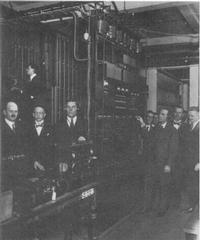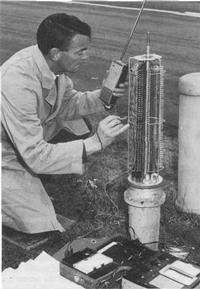


Chapter 8
I Part 1: Communications
i Before the Telegraph
ii Electrical Communication Before Federation
iii Federation to the End of the Second World War
iv Post-war and on to 1975
v 1975 ONWARDS
II Epilogue
III Part 2: Early Australian Computers And Computing
IV Acknowledgements
References
Index
Search
Help
Contact us

Federation to the End of the Second World War (continued)
The introduction of carrier systems and amplifiers made it possible for the first time to contemplate a national trunk system, but this required also extra facilities in trunk exchanges, including pad switching and on occasion, cord circuit amplifiers. Signalling requirements were changing also, as instanced by 500 Hz signalling on the early carrier systems and 1000 Hz in later installations. Another signalling problem came as the capital city networks were converted to automatic working and it became attractive to allow country telephonists to dial subscribers directly, a development referred to in the 1923/24 Annual Report of the Department. Although definite records are not available, the signalling equipment employed appears to have been developed locally, using a variety of methods such as D.C. signalling over the loop and various derived signalling paths. Although VF dialling was being developed overseas, commercial equipment was not available and in the 1930s several States evolved their own systems, with South Australia for instance using a frequency of 220 Hz and a system providing both way working and had 47 trunks equipped by 1940. The name of F. P. O'Grady was associated with much of the South Australian work.[21]These various developments gave rise to the need for a new type of trunk exchange and a sleeve control installation was provided first in Hobart in 1929. Connection of trunk calls when the subscriber rang -'demand working' was the term employed -instead of the traditional delay and ring back system, also began to emerge, bringing with it complex exchange management tasks for large exchanges. On the carrier side, the first 12 channel open wire system, using equipment supplied by AT&T and operating in the frequency band to 148 kHz, was installed between Sydney and Melbourne in 1938 on a copper pair transposed to the basic double extra type P2. Thus a quite sophisticated trunk network developed, which in 1937/38 handled a total of some 40 million trunk calls and which by 1939 comprised a total of 5,540 circuits. Many problems remained, however, and the quality of service varied widely. Vacuum tube technology impacted in a positive way in the telegraph service also, with the first Voice Frequency Telegraph System installed in 1927, while two years later Australia's first picturegram service opened between Sydney and Melbourne.
By 1939 there were 487,000 subscribers connected to the network, and much attention was being given also to the cable and open wire systems connecting these subscribers to their local exchanges. Lead sheathed, paper insulated, copper pair cables were the standard, but with open wire construction still used in reticulation to many suburban homes. Electrolytic corrosion of lead cable sheaths, often influenced by stray currents from tramway systems, led to a deal of work to improve cable sheath life. The need for economic and low fault incidence cable reticulation systems resulted in a range of innovations including the development of the Australian pillar terminal, which avoided frequent opening of cable joints. Early models of the pillar terminal encountered problems, particularly from moisture condensation and the equipment was progressively developed over the years to become a standard part of the network.


People in Bright Sparcs - O'Grady, F. P.
 |
Australian Academy of Technological Sciences and Engineering |  |
© 1988 Print Edition page 554, Online Edition 2000
Published by Australian Science and Technology Heritage Centre, using the Web Academic Resource Publisher
http://www.austehc.unimelb.edu.au/tia/542.html